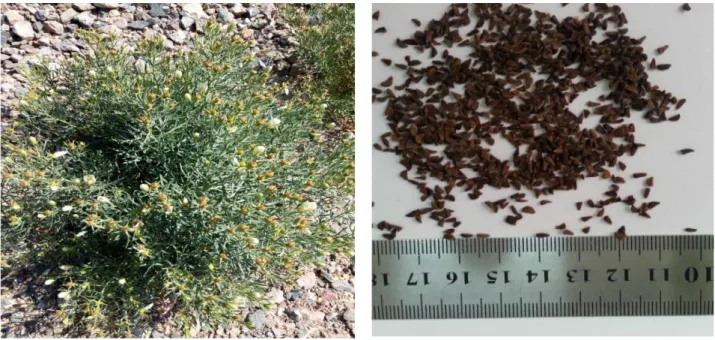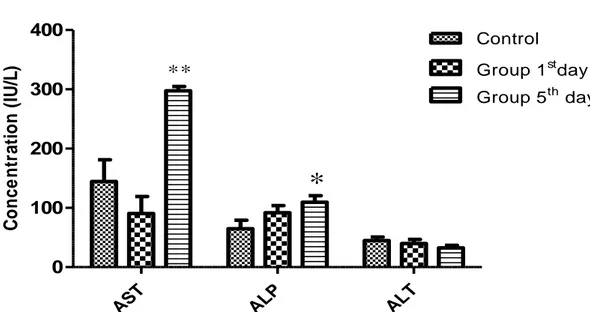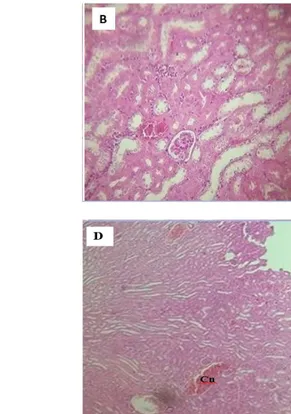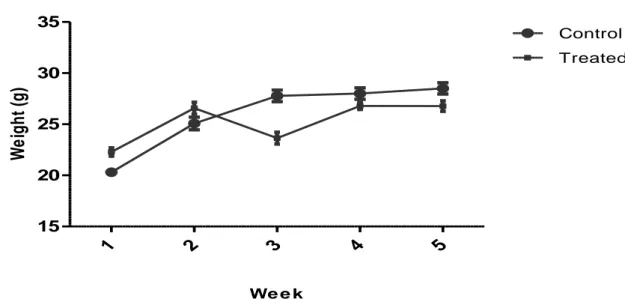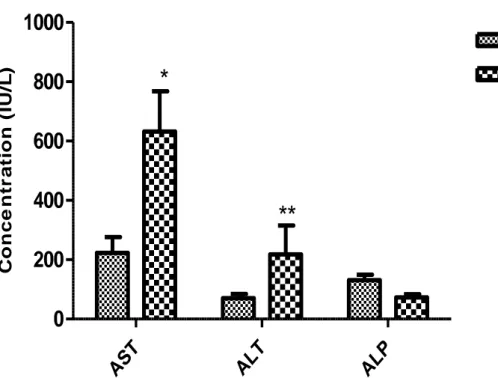1Department of Biology, Faculty of natural sciences and life, University Elbachir El Ibrahimi, Bordj Bou Ariridj 34000, Algeria.
2Department of Biochemistry, Faculty of natural sciences and life, University Ferhat Abbas, Setif 19000, Algeria.
Received: 16th July, 17; Revised 24th Aug, 17, Accepted: 14th Sept, 7; Available Online:25th Sept, 17
ABSTRACT
The objective of the study was to evaluate the acute and subacute toxicity of total alkaloids seeds of Peganum harmala in female mice. All morphological, biochemical, hematological, histopathological changes, in addition to mortality and bodyweight changes were recorded. After acute intraperitoneal administration of dose118 mg/kg, there were no any remarkable changes in general appearance and mortality. After 24h, a significant increase in relative weights of heart and brain with no change in hematological, biochemical parameter compared to the normal group. For 5 days a significant reduction in the relative weights of the kidneys and increase of brain with significant change in hematological (MCHC, MCV) and biochemical parameter (AST, ALP and Urea). Subacute study of dose (18 mg/kg) for 28 days showed no remarkable changes in general appearance and deaths occurred in experimental group. A significant increase in relative weight of brain compared to the normal group was observed. In biochemical parameters, a significant increase was seen in both ALT and AST enzyme activities. There was no significant change in hematological parameters. Histopathological examination revealed a ground glass appearance of hepatocytes and the vascular congestion. Alkaloids seeds of P.harmala showed significant toxicity in female mice.
Keywords: Peganum harmala; acute toxicity; subacute toxicity; mice; alkaloids INTRODUCTION
Peganum harmala L. known locally as “harmel” in
Algeria1 is a wild-growing flowering plant that belongs to the Zygophyllaceae family and is considered an important medicinal plant2. The pharmacologically active compounds of this plant include a number of 𝛽-carboline (such as harmine, harmaline, harman and harmalol) and quinazoline alkaloids (vasicine and vasicinone) responsible of its pharmacological and toxicological effects3. Its root has been used as a parasiticide to kill body lice and leaves are used for treating rheumatism and nervous conditions where as seeds are used externally in the treatment of haemorrhoids and baldness4.
The alkaloids in the seeds have pharmacological activities which including: antibacterial effects, vasorelaxant, anticancer, antinociceptive, antitumor and finally antiprotozoal effects. In addition to the therapeutic effects, harmal also has some toxicity. There were several reports of human and animal intoxications induced by the plant5,1. There have been some toxic symptoms reported in different human cases following ingestions of its seed extract or infusion, such as neuro-sensorial symptoms, visual hallucinations, and cardiovascular disorders such as bradycardia and lowblood pressure, psychomotor agitation, diffuse tremors, ataxia and vomiting6,7. The aim of the present study was therefore, to investigate the acute
and subacute toxic effects of the total alkaloids seeds of
Peganum harmala in mice.
MATERIALS AND METHODS
Plant material and extraction
The seeds of Peganum harmala were collected in the month of August, in the region Bordj Bou Arreridj (north-east of Algeria). The plant was identified on the basis of its morphological characteristics.
Total alkaloids extraction
Hundred gram of Air dried powdered of seeds was defatted with petroleum ether under reflux. The defatted dry powder was alkalized with 40 ml of NH4OH (0.5 N) for 8 hours and were extracted to exhaustion with dichloromethane using a soxhlet apparatus for 6 h. The organic extract (containing free alkaloids and lipophilic impurities) is washed three times with 150 ml aqueous sulphuric acid (0.5 N).
The solution obtained is treated with NH4OH (0.5 N) to pH 9 to liberate the free alkaloids then are separated three times by extraction with 3 x 150 ml diethyl ether and then dried with Na2SO4 and concentrated to dryness under reduced pressure to obtain crude alkaloids8 .
Animals
Female Swiss albino mice (25-30g), obtained from the animal house of the Pasteur Institute in Algiers, were used
for the acute and subacute toxicity study. They were housed in hanging transparent plastic cages (55 x 33x19cm) in the animal room. The litter was renewed every 3 days. They were fed with a standard pellet and tap water ad libitium.
All animals were kept in standard environmental. Each mouse was identified by body marks using 1% picric acid solution. All experimental procedures were conducted in accordance with the guide for care and use of laboratory animals and in accordance with the scientific council of the Faculty of Natural Sciences and Life of the University Ferhat Abbas, Setif 1 – Algeria.
Acute toxicity
The total alkaloids of P.harmala to be tested is dissolved in methanol and diluted by normal saline solution (v/v 0.9%).
The mice were grouped into three groups of 10 mice each. Two groups were given single dose (118 mg/kg of total alkaloids of seeds of Peganum harmala by intraperitoneal route.
The control group (10 mice) received saline water. At the end of all experimental periods, the first group was sacrificed after 24 hour of treatment, the second and control groups after 5 days9.
Subacute toxicity
The female mice (20–25 g) were divided into two groups of 15 animals each and were placed under standard Figure 1: Peganum harmala. Figure 2: Seeds of Peganum harmala.
Table 1: Relative organ’s weight of female mice treated with (118 mg/kg) of total alkaloids of Peganum harmala seeds. Results were expressed as the mean ±S.E.M.
Organ Control Group 1stday Group5th day Liver 0.051± 0.002 0.051±0.003 0.058±0.002 Kidneys 0.0142 ± 0.002 0.0092±0.0003 0.0087±0.0004* Spleen 0.0041±0.0002 0.0168±0.008 0.0047±0.0003 Heart 0.0049±0.0002 0.0145±0.0003*** 0.0045±0.0001 Lungs 0.0095±0.001 0.139±0.006 0.0067±0.0001 Brain 0.0129± 0.0004 0.0148±0.0003* 0.149±0.0004* * Significantly different at P< 0.05
Table 2: Effect of acute administration of total alkaloids of Peganum harmala seeds (118 mg/kg) on some hematological parameters .Results were expressed as the mean ±S.E.M.
Parameters Control Group 1stday Group5th day RBC 106/mm 7.737 ± 0.292 7.914 ± 0.270 7.39 ± 0.180 MCV fL 45,90 ± 0,511 44,42 ± 0,760 42,05± 0,424** HCT % 35± 1 37±2 31±0.9 WBC 103/mm 6,233 ± 0,6412 6,371 ± 0,8676 6,980 ± 1,877 PLT 103/mm 249±41.43 412.7±50.06 413.7±56.77 HGB g/dl 12,83 ± 0,306 13,65 ± 0,433 12,57 ± 0,260 MCH pg 16,68 ± 0,439 16,53 ± 0,413 17,07 ± 0,525 MCHC g/dL 36.33±0.73 37.05±1.51 40.63±1.27* * Significantly different at P< 0.05
conditions. Tested group received (18 mg/kg) of alkaloids for 28daysand control received vehicle at the same volume. The animals were weighed on the first day of the experiment and thereafter were then weighed each week, to note any weight variation.
Determination of hematological and serum biochemical parameters
The hematological and serum biochemical parameters were determined. Hematological parameters assayed included red blood cell (RBC) count, leukocyte (WBC) count, haemoglobin (HGB), haematocrit (HCT), mean corpuscular volume(MCV), mean corpuscular haemoglobin (MCH), mean corpuscular haemoglobin concentration (MCHC), platelet count (PLT) ,Serum was
AS
T
AL
P
AL
T
0
100
200
*
Co
n
c
e
n
tr
a
ti
o
n
Figure 3: Effect of acute administration of total alkaloids of Peganum harmala seeds (118 mg/kg) on some biochemical parameters (hepatic function) of female mice. Results were expressed as the mean ±S.E.M.* significantly different at
P< 0.05.
C
réa
tinin
e
U
rea
0
2
4
6
Control
Group 1
stday
Group 5
thday
*
*
*
C
o
n
c
e
n
tr
a
ti
o
n
Figure 4: Effect of acute administration of total alkaloids of Peganum harmala seeds (118 mg/kg) on some biochemical parameters (renal function) of female mice. Results were expressed as the mean ±S.E.M.* significantly different at P<
assayed for creatinine, urea, (AST),(ALT), (ALP). For the determination of hematological parameters was used medonic hematology analyzer systems (M-series), for the biochemical parameters was used an Advia 1800 Chemistry Analyzer, Siemens.
Histopathology
Immediately after collection of blood samples by cardiac puncture, animals were sacrificed. After autopsy, all tissues were examined grossly and major’s organs (liver, brain, heart, kidneys, Spleen, and lung) were weighted. Figure 5: Histological section of kidney tissue with a single dose of (118 mg/Kg) :( A): control group. Treated groups;
(B): After 24h; C: After 5 days; (D): After 28 days. (Hematoxylin/eosin stain). GL: glomerulus, KT: kidney tubes, Cn: Congestion. X40.
Figure 6: Histological sections of liver tissue with a single dose of 118 mg/kg: control group (A), treated groups; (B): After 24h ;(C): After 5 days; (D): After 28 days. Cn: Congestion; GGA: Ground Glass Appearance of hepatocytes. X40.
The relative organ weight of control and treated was calculated. Tissues from liver and Kidneys of all animals were fixed in 10% buffered formalin solutions then embedded in paraffin and cut with a microtome set at 5μm, stained with hematoxylin and eosin and examined by light microscopy for histopathological changes.
Statistical analysis
Comparisons among different groups were performed by One-way ANOVA and t” Student test using the software Graphpad Prism version 5.01. All data are expressed as mean± (SEM); Differences between groups were considered significant at p<0.05 levels.
RESULTS
Acute toxicity of total alkaloids
No signs of toxicity in general appearance observed after intraperitoneal administration of single dose tested (118mg/kg). None of the mice in all treated groups died during the course of the experiment.
The macroscopic examination of various organs in situ did not show any morphological changes in organs of treated animals compared with those of control.
The relative weights of heart and brain after first day were significantly increased compared to control. The group sacrificed after 5 days of treatment has presented a significant reduction in the relative weights of the kidneys and increase of brain compared to control group (Table 1). The results of the hematological tests are summarized in (Table 2). All the tested hematological parameters were within normal limits compared to control group for the first day of treatment with total alkaloids seeds of Peganum
harmala. No toxicologically significant differences
between treated animals and control were found (Table 2).The group sacrificed after 5 days of treatment has presented significant decrease in MCHC and increase in MCV when compared with control (Table2).
The results of the various biochemical tests on the experimentally treated animals and control group are summarized in (Fig.3.4). Intraperitoneal administration of total alkaloids seeds of Peganum harmala did not cause significant changes in serum biochemical parameters such as Urea, Creatinine, AST, ALT and ALP levels when compared to control group for the first day of treatment, However, AST, ALP and Urea were significantly increased in treated animals when compared to control group after 5 days of treatment (Fig3.4).
1
2
3
4
5
15 20
We e k
Figure 7: Effect of subacute administration of total alkaloids on body of female mice, values are Mean± SEM. Table 3: Relative organ weights (g) of mice in the
subacute toxicity study treated with 18 mg/kg of total alkaloids of Peganum harmala seeds. Results were expressed as the mean ±S.E.M.
Group Control Treated for 4 weeks Liver 0.051± 0.0030 0.046±0.0016 Brain 0,014 ± 0,0004 0,031 ± 0,016*** Kidney 0,0107± 0,0005 0,0099 ± 0,0003 Lungs 0,0068 ± 0,0003 0,0077 ± 0,0004 Heart 0,0050 ± 0,0002 0,0047 ± 0,00018 Spleen 0,0057 ± 0,0002 0,0052 ± 0,0003 * Significantly different at P< 0.05
Table 4: Effect of subacute administration of total alkaloids of Peganum harmala seeds (18 mg/kg) on some hematological parameters .Results were expressed as the mean ±S.E.M.
Parameters Control Treated for 4 weeks RBC 106/ 07,820 ± 0,2474 08,471 ± 0,2194 MCV fL 53,50 ± 0,5000 51,57 ± 0,7825 HCT % 43,78 ± 2,082 43,61 ± 1,232 WBC 103/mm 7,017 ± 0,9148 6,043 ± 0,9614 PLT 103/mm 924,8 ± 80,16 1009 ± 121,9 HGB g/dl 13,52 ± 0,2701 14,31 ± 0,2040 MCH pg 17,30 ± 0,3445 16,96 ± 0,3221 MCHC g/dL 32,35 ± 0,4759 32,97 ± 0,6171 * Significantly different at P< 0.05
The histological examination of liver and kidneys from female mice were performed in both control and treated groups. The results of the kidneys at the dose applied (118 mg/kg) revealed no destruction architecture (Fig.5). However, histological examination of the liver in the treated animals after 24 h and 5th days of treatment revealed
a ground glass appearance of hepatocytes, and the vascular congestion (Fig.6).
Subacute toxicity
No clinical toxicity signs were observed in the treated group compared to the control group. None of the mice in the treatment or control groups died during the course of
AS
T
AL
T
AL
P
0
200
400
600
800
1000
Control
Treated
*
**
Co
n
c
e
n
tr
a
ti
o
n
(
IU/
L
)
Figure 8: Effect of subacute administration of alkaloids of Peganum harmala seeds (18 mg/kg) on some biochemical parameters (hepatic function) of female mice. Results were expressed as the mean ±S.E.M.* significantly different at
P< 0.05.
Cre
at
inin
e
Ure
a
0
1
2
3
4
5
Control
Treated
Co
n
c
e
n
tr
a
ti
o
n
Figure 9: Effect of subacute administration of total alkaloids of Peganum harmala seeds (18 mg/kg) on some biochemical parameters (renal function) of female mice. Results were expressed as the mean ±S.E.M.* significantly
The results of the various biochemical tests on the experimentally treated animals for 28 days and control group are summarized in (Table7). Significant differences in treated animals for AST and ALT levels when compared to control group.
DISCUSSION
In the toxicity study, organ weight is an important indicator of physiological and pathological status of animals. The relative organ weight is fundamental to confirm whether the organ weight was exposed to the injury or not. Increased in the heart, liver, kidney, spleen and lungs are the primary organs affected by metabolic reaction caused by toxicant10 .We observed a significant increase in heart (1stday), brain (1st and 5th day) and significant decrease in kidneys (5th days) of treatment at a dose 118 mg/kg, may indicate that the extract might have toxic potential on these organs. It could be argued that these changes may be toxicologically significant, as they were corroborated by the biochemical and histomorphology findings. Therefore, this study indicates that total alkaloids of Peganum
harmala cause acute toxicity effects at the dose tested11. Haematopoietic system is one of the most sensitive targets of toxic compounds and is an important index of physiological and pathological status in man and animals12. A significant decrease in mean corpuscular volume (MCV), but increase in means corpuscular hemoglobin concentration (MCHC) after 5thdays of treatment were observed. These parameters are useful as the RBC indices for differential diagnosis of anaemia13.In addition the MCV has been reported to provide information on the size and status of erythrocytes, MCH and MCHC reflect the haemoglobin content of RBCs14 .However the non-significant difference on the RBC, Hb (red blood cell counts and haemoglobin concentration) suggested that the total alkaloids of Peganum harmala did not affect a change in the average size of RBCs. By extension, it did not induce anemia15.
Transaminases such as AST (SGOT), ALT (SGPT) are well known good indicators of liver function and used as biomarkers to conclude the probable toxicity of drugs and xenobiotics16. Significant increases in the levels of some biochemical parameters, particularly ALP, were observed in the female mice treated with total alkaloids after 5th days of treatment, as compared with the control. Moreover a hepatic alkaline phosphate is found histochemically in the microvilli of bile canaliculi and on the sinusoidal surface of hepatocytes17. Although elevated levels of (ALP) have been associated with bone diseases, it is also an indicator for obstructive jaundice and intra-hepatic cholestasis18
significant increase in the serum levels of urea and the non-significant reduction in creatinine in the extract-treated mice is an indication that the kidney is able to clear the waste products from the system; this is also indicative that the extract had no deleterious effect in kidney20. Moreover the increase in Urea and AST levels could be explained the effect of alkaloids on the heart, brain or skeletal muscle. Studies have reported the effect of harmel on the brain and heart in humans6, 21,22.
In the subacute toxicity study in female mice given the alkaloids, there were no significant changes in weight of body and organs except in increase of brain. All the animals exhibited a normal increment in body weight without drastic difference between both control and treated groups.
Sub-acute administration of total alkaloids of Peganum
harmala did not cause significant changes in the
haematological profile of female mice when compared with control, suggesting that the alkaloids may not be toxic to the blood system. For biochemical parameters the observed significant increase in ALT and AST activity in the test group compared to control may signify liver injury as seen in liver dysfunction, damage and liver diseases. Because the transaminases (AST and ALT) are well known enzymes used as biomarkers to predict possible toxicity, generally damage to liver cells will result in elevation of both these enzymes in the serum16. Increase in the activities of AST and ALT in the treated groups indicates that alkaloids of Peganum harmala have capacity to induce liver damage under conditions of subacute toxicity. Renal dysfunction can be assessed by concurrent measurements of urea, creatinine and uric acid and their normal levels reflect at reduced likelihood of renal problems23.
In the present study, the insignificant changes in serum levels of urea and creatinine in female mice suggest that subacute administration of alkaloids does not affect the kidney function.
Histological changes in the kidney and liver of the animals were also examined. The histology slides of the kidneys at dose (118 mg/kg) showed no destruction to kidney architecture this observation as further confirmed by the biochemical biomarkers for renal function but on congestion was observed in subacute administration. The liver histology results revealed a ground glass appearance of hepatocytes (hepatocytes show enlarged and pale-staining cytoplasm) in acute toxicity and the vascular congestion in under conditions of acute and subacute toxicity.
In summary, acute and subacute toxicity study of Peganum
harmala indicated that the total alkaloids seeds extract at
the dose studied produce significant changes of biochemical parameters and histopathology of internal organs. Further studies to determine the chronic toxicity of this extract on animal are needed.
REFERENCES
1. Mahmoudian M, Jalilpour H, Salehian P. Toxicity of
Peganum harmala: Review and a case report. Iran J
Pharmacol Ther 2002; 1:1–4.
2. Berdai MA, Labib S, Harandou M. Peganum harmala L. Intoxication in a Pregnant Woman. Case Reports in Emergency Medicine 2014 .Article ID 783236. 3. Edziri H, Mastouri M, Matieu M, Zine M, Gutman L
and Aouni. Biological activities of Peganum harmala
leaves. Afr. J. Biotechnol 2010; 9(48):8199-8205.
4. Asgarpanah J, Ramezanloo F. Chemistry, pharmacology and medicinal properties of Peganum
harmala L. African J. Pharmacy and Pharmacology
2012; 6:1573-1580.
5. El Bahri L; Chemli R. Peganum harmala L: A poisonous plant of North Africa. Vet. Hum. Toxicol. 1991; 33: 276–277.
6. Frison G, Favretto D, Zancanaro F, Fazzin G, Ferrara SD. A case of β-carboline alkaloid intoxication following ingestion of Peganum harmala seed extract. Forensic Sci. Int 2008; 179, e37–e43.
7. Lamchouri F, Settaf A, Cherrah Y, El Hamidi M, Tligui N, Lyoussi B, Hassar M. Experimental toxicity of
Peganum harmala seeds. Ann. Pharm. Fr 2002; 60,
123–129.
8. Bruneton J. Pharmacognosie. Phytochimie, Plantes médicinales” 3e éd., 1999.Lavoisier, Paris.
9. Bouzidi A, Mahdeb N, Kara N. Acute toxicity study of alkaloids of Datura stramonium seeds in rat. Roavs 2011; 1(8): 482-488.
10. Dybing E, Doe J, Groten J, Kleiner J,O’Brien J. Hazard characterization of chemicals in food and diet: dose response, mechanism and extrapolation issues. Food Chem. Toxicol 2002; 42: 237-282.
11. Kwan Y P, Ibrahim D, Yeng C, Subramaniam S, Sreenivasan S. Acute and Subchronic Toxicity Study of
Euphorbia hirta L. Methanol Extract in Rats. BioMed
Research International 2013; 14:1–14.
12. Adeneye AA, Ajagbonna OP, Adeleke TI, Bello SO. Preliminary toxicity and phytochemical studies of the stem bark aqueous extract of Musangacecropioides in rats. J Ethnopharmacol 2006; 105: 374-379.
13. Voigt GL. Anemias and Polychythenias. In Hematology Techniques and Concepts for Veterinary Technicians.Iowa State University Press, U.S.A.2000.pp 95 – 101.
14. Nussey GJ, Van Vuren JHJ, Du Preez HH. Effects of copper on the haematology and osmoregulation of the Mozambicus tilapia, Oreochromismossambicus
(Cichlidae). Comp Biochem Physiol 1995; 111:369-380.
15. Narhari D, Durajan G, Sharif Hasan MD, Sheikh Z R. Evaluation of acute and subacute toxicity induced by methanol extract of Terminaliacitrina leaves in Sprague Dawleyrats. J Acute Disease 2015; 4(4): 316–321. 16. Rahman MF, Siddiqui MK, Jamil K. Effects of
Vepacide (Azadirachtaindica) on aspartate and alanine aminotransferase profiles in a sub chronic study with rats. J Hum Exp Toxicol 2001; 20: 243–249.
17. Thapa BR, Anuj W. Liver Function Tests and their Interpretation. Indian J of Pediatrics 2007;74 :663-671. 18. Adebayo AH, Abolaji AO, Opata TK, Adegbenro, IK. Effects of Ethanolic Leaf Extract of Chrysophyllumalbidum G. on Biochemical and Haematological Parameters of Albino Wistar Rats. Afr J.Biotech 2010 ; 9(14):2145-50.
19. R. A Sacher, R. A. Mepherson. Widmann's Clinical Interpretation of Laboratory Test,” 3rd ed., FA Davis Company; Pennsylvania, U.S.A, 1991.
20. Olufunsho A, Kennedy I A, John A, Majeti NVP .Toxicological evaluations of the aqueous stem bark extract of Brideliaferruginea (Euphorbiaceae) in rodents. InterdiscipToxicol 2015; 8(2): 89–98.
21. Moshiri M, Etemad L, Javidi S, Alizadeh A. Peganum
harmala intoxication, a case report. Avicenna J
Phytomed 2013; 3(3): 288-292.
22. Nasehi M, Piri M, Nouri M, Farzin D, Nayer-Nouri T, Zarrindast M R. Involvement of dopamine D1/D2 receptors on harmane-induced amnesia in the step-down passive avoidance test. Eur J Pharmacol 2010; 634:77–83.
23. Palm, M, Lundblad A. Creatinine concentration in plasma from dog, rat, and mouse: A comparison of 3 different methods. Vet. Clin. Pathol 2005; 34, 232–236.
